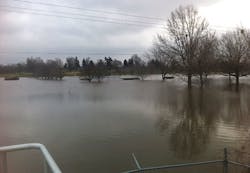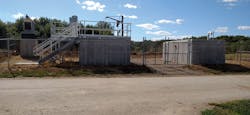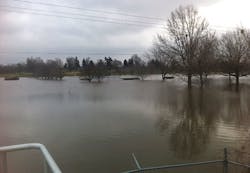Utilizing the Hazard Mitigation Grant Program to Protect a Sewage Pump Station
By Tim Sumner
Founded in 1869, the Village of Rochester, Ill., serves a population of over 3,700. Its sewer system began with lagoon treatment in the 1950s, before the village was annexed into the Sangamon County Water Reclamation District (SCWRD), then known as the Springfield Metro Sanitary District, in the early 1990s. In 1992, lagoons were converted to excess flow storage and a primary pump station was constructed to send all sewage to the reclamation district for treatment. This served the entire village. Primary pump station structures - including a wet well, valve vault and a standby generator - were constructed at an elevation one foot higher than the regulatory base flood elevation (BFE).
Primary pump station service was threatened twice, in 1992 and again in 2002, by backwater from the South Fork Sangamon River. Flood waters surrounded the primary pump station, making the station accessible only by boat. To preserve the primary pump station operation, the Village was forced to sandbag the structures. After the second flooding event and near loss of sewer service to residents, the Village began exploring avenues to fund protection of the pump station against future flooding. High-water marks were documented (by elevation) for future mitigation efforts. Without documentation of the high-water marks, there would be no proof of the extent of the flooding and needed mitigation efforts.
The purpose of the Hazard Mitigation Grant Program (HMGP) is to help communities implement hazard mitigation measures following a Presidential Disaster Declaration. The HMGP is administered by the Federal Emergency Management Association (FEMA), with administration assistance from the state EMA (in this case, the Illinois Emergency Management Association [IEMA]). HMGP is a unique source of funding that can be creatively applied to public infrastructure that is vulnerable to extreme weather events such as flooding. Projects must provide a long-term solution to a recurring disaster problem. FEMA HMGP grants may fund up to 75 percent of the eligible costs of each project. The grantee must provide a 25 percent match.
Rochester’s eligibility to apply for HMGP funds hinged on two factors. First, the completion of Sangamon County’s Hazard Mitigation Plan, which was approved by FEMA in 2008 (plan is effective for five years and must be current). Second, a Presidential Disaster Declaration, which occurred in 2010 after severe storms and flooding occurred in Illinois.
Once HMGP funding was possible, the Village asked consulting engineering firm Crawford, Murphy & Tilly (CMT) to evaluate the pump station and make recommendations for improvements so services would not be interrupted during major flooding events in the future. An inquiry was made and IEMA allowed CMT and the Village to submit a project description in late 2011, then offered solution alternatives in early 2012.
FEMA agreed that the mitigation solution needed to protect the pump station to an elevation of 549 feet. Three solution alternatives were presented to FEMA, the Village and other stakeholders:
- A highway barrier wall outside of the fence.
- A retaining wall with security fence and flood gate.
- Raising the top of the wet well, valve vault and generator pad to an elevation of 549 feet. (This solution was selected.)
The first two alternatives (the highway barrier and the retaining wall) required active intervention in the case of flooding, whereas the chosen solution did not require action from Public Works staff. The “passive” nature of this alternative was one of the main reasons FEMA recommended it and the Village chose to raise the structures as its mitigation solution.
CMT’s final design of the mitigation work at the primary pump station included raising the wet well, valve vault, and standby generator pad using cast-in-place and pre-cast concrete. All the original electrical controls were located on top of the wet well.
Once stakeholder feedback was collected and project priorities identified, CMT developed a detailed project description and project cost estimate. Project team members also examined whether there were other needed improvements that could be made within the project scope while the pump station was offline. They identified pump station features in need of replacement or updating as part of the overall improvements. Reasonable costs for features to be replaced were included in the grant application with supporting information.
Before a HMGP grant could be awarded, the following conditions had to be met:
- A grant agreement with IEMA, as well as quarterly progress reports.
- A resolution by local government agreeing to accept the grant.
- Federal language for all agreements, such as no kickbacks and paying federal wages.
- Adherence to the “Buy American Act” - only steel, iron and manufactured products produced in the U.S. are eligible.
- The utilization of the Qualifications-Based Selection (QBS) process if hiring third-party consultants, and all contractors must adhere to grant agreement requirements.
Work on the HMGP online grant application took several days to complete and required multiple submissions. To justify the HMGP grant application, CMT and the Village prepared a benefit-cost analysis (BCA). A project is considered cost-effective when the benefit-cost ratio is 1:0 or greater, indicating the benefits of a prospective hazard mitigation project are sufficient to justify the costs. Also, HMGP grant applications for funding pump stations was not typical for FEMA since they are more accustomed to providing funds to buy repetitive loss properties. The process was lengthy, and at one point delayed due to another natural disaster.
Upon award of a 75 percent HMGP grant for the work, CMT prepared plans and specifications, along with bidding and contracting documents to facilitate competitive bidding. Special attention was given to including the appropriate forms and contracting requirements imposed by the grant agreement. The Village Public Works staff and CMT developed contractor sequencing and mobilization requirements since the pump station was taken out of service during improvements. A by-pass pumping plan was developed with input from the Public Works staff to ensure smooth transitions between shut-down and start-up. A contract was awarded to the lowest responsible bidder in the fall of 2014. Construction started in the spring of 2015 and was completed by mid-summer.
Shortly after all mitigation improvements were completed in 2015, another flooding event occurred. At the end of December 2015, backup from the South Fork Sangamon River flooded Rochester. Sewer mains were inundated, but the primary pump station stayed operational despite the surrounding flood waters thanks to the structures being elevated.
About the Author: Timothy Sumner, PE, CFM, CSM, is a project manager at Crawford, Murphy & Tilly (CMT). He can be reached at [email protected].


